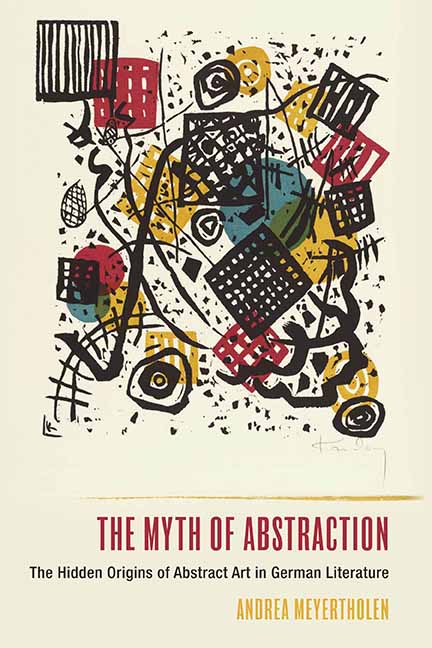Book contents
- Frontmatter
- Dedication
- Contents
- List of Illustrations
- Acknowledgments
- Introduction: The Many Origins of Abstract Art
- 1 Apocalypse Now: Heinrich Von Kleist’s Sublime Deframing of Caspar David Friedrich’s Der Mönch Am Meer (1810)
- 2 The Kleistian Sublime Is Now: Kazimir Malevich, Mark Rothko, Barnett Newman
- 3 The Clouding of Perception: Seeing The (Un)Real Potential for Abstraction in the Poetry and Science of Goethe’s Clouds (1821)
- 4 In the Service of Clouds or Optical Illusion?: Romanticism, Pointillism, and Impressionism
- 5 Driven to Distraction and from Abstraction: The Birth and Death of Abstract Art in Gottfried Keller’s Der Grüne Heinrich (1854/55, 1879/80)
- 6 Inside the Mind and Outside the Margins: The Unruly Lines of Paul Klee, André Masson, and Cy Twombly
- Epilogue: Laocoön and His Sisters: The Future of Literature and Art
- Bibliography
- Index
4 - In the Service of Clouds or Optical Illusion?: Romanticism, Pointillism, and Impressionism
Published online by Cambridge University Press: 07 May 2022
- Frontmatter
- Dedication
- Contents
- List of Illustrations
- Acknowledgments
- Introduction: The Many Origins of Abstract Art
- 1 Apocalypse Now: Heinrich Von Kleist’s Sublime Deframing of Caspar David Friedrich’s Der Mönch Am Meer (1810)
- 2 The Kleistian Sublime Is Now: Kazimir Malevich, Mark Rothko, Barnett Newman
- 3 The Clouding of Perception: Seeing The (Un)Real Potential for Abstraction in the Poetry and Science of Goethe’s Clouds (1821)
- 4 In the Service of Clouds or Optical Illusion?: Romanticism, Pointillism, and Impressionism
- 5 Driven to Distraction and from Abstraction: The Birth and Death of Abstract Art in Gottfried Keller’s Der Grüne Heinrich (1854/55, 1879/80)
- 6 Inside the Mind and Outside the Margins: The Unruly Lines of Paul Klee, André Masson, and Cy Twombly
- Epilogue: Laocoön and His Sisters: The Future of Literature and Art
- Bibliography
- Index
Summary
THE IDEA OF DERIVING a theoretical construct for a cognitive mode of scientific viewing of the sort that Goethe's lebendiges Anschauen represents and then applying it to the realm of art originates with Goethe himself. In addition to the Farbenlehre's desired practical application for painting, Goethe believed that art and artists could greatly benefit from the mode of lebendiges Anschauen necessary for botanists to perceive the metamorphosis of plants, for geologists to grasp the underlying patterns of rock formation, or for a scientist like Howard to classify the clouds. Given Goethe's aesthetic sensibilities, the author envisaged quite a different role for the cognitive viewing subject than the “clouding of perception” at stake for abstract art. He conceived of its value as a means of furthering the genre of landscape painting, encouraging artists to study nature with a lebendiges Anschauen that would provide the final product with a scientific basis. To be clear, Goethe was not looking to subordinate or enslave art in the service of science; rather, he was looking to enhance the character of its truthfulness and beauty. The insights provided by scientific study would allow the artist to grasp the inner essence of the phenomenon, to understand the natural processes bringing it into being, and to better represent its intrinsically dynamic reality on canvas.
To realize this calling as it pertained to clouds, Goethe approached artist acquaintances of his with the request for a series of cloud studies illustrating Howard's cloud classifications because no visual account of that sort existed yet. Although he considered himself, among many other things, an amateur artist and, like Howard, even produced sketches of the typological categories, he recognized that a professional was needed in order to do the endeavor justice. The mutable behaviors of clouds had bedeviled artists for centuries, as their conspicuous absence in pre-Renaissance painting indicates. Even seventeenth-century Dutch landscape painting, with the benefits that optical devices and the awareness of weather events afforded it, could not execute cloud forms that were naturally accurate and in perspectival harmony with the land or sea below them. Howard's classification scheme provided the long-needed paradigm for interpreting a meteorologically accurate and a harmoniously integrated cloud, and Goethe made it his mission to put this knowledge at artists’ fingertips.
- Type
- Chapter
- Information
- The Myth of AbstractionThe Hidden Origins of Abstract Art in German Literature, pp. 138 - 173Publisher: Boydell & BrewerPrint publication year: 2021



